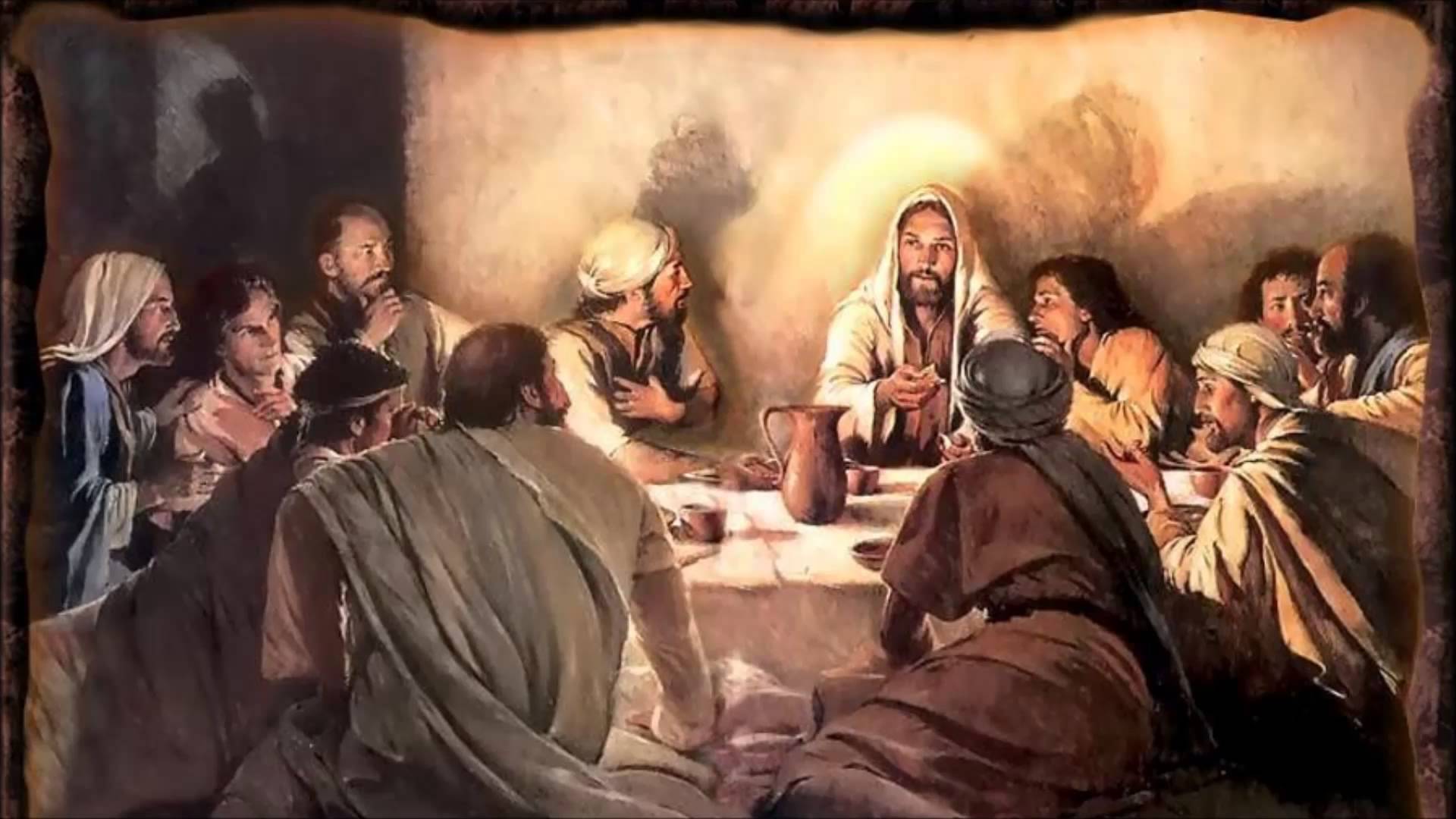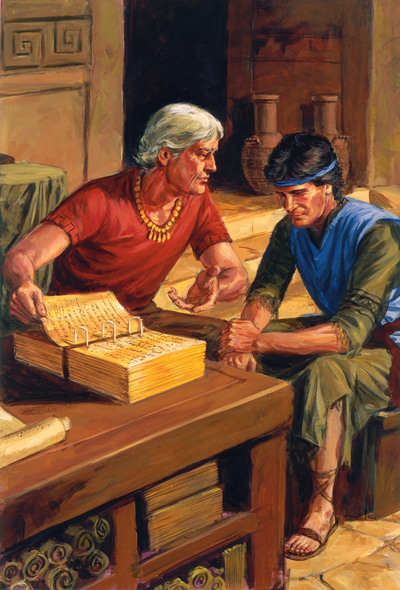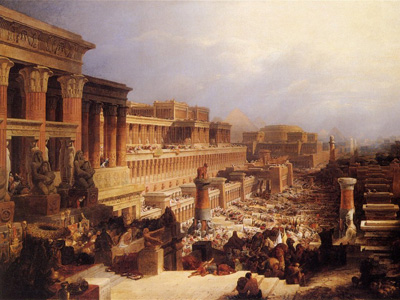You are here
Did Alma Counsel His Sons During the Passover?

Alma 38:5
The Know
After their ministry among the Zoramites, Alma “caused that his sons should be gathered together, that he might give unto them every one his charge, separately, concerning the things pertaining unto righteousness” (Alma 35:16). On this occasion, Alma’s exhortation to his sons may be linked to an ancient Jewish practice associated with the Passover. Gordon C. Thomasson and John W. Welch related:
According to traditions at least as early as the time of Christ and probably earlier, after gathering his family the father then instructed his sons and answered their questions. His words were not fixed but were “to fit the knowledge and understanding of the child” and were supposed “to spell out the sequence of sin, suffering, repentance, and redemption.”1
Although it is unknown how early this particular practice began, the feast of Passover was always celebrated as an important time for family gatherings, eating of the pascal lamb, and remembering the traditional texts associated with God’s deliverance of Israel from servitude in Egypt. Furthermore, it is important to note that scholars understand this Passover ceremony to be developed over time from earlier wisdom traditions.2 It is possible that Alma’s exhortation to his sons could have thematically descended from early strains of these same interweaving wisdom traditions.
What makes the link between Alma’s words to his three sons and this Passover tradition particularly striking is that, according to some Jewish customs, the sons asking questions often played out different roles and characters.3
The first was a wise son, who quoted from Deuteronomy, asking: “What mean the testimonies, and the statutes, and the judgments, which the Lord our God hath commanded you?” (Deuteronomy 6:7). Alma’s eldest son, Helaman, clearly stands out as Alma’s favored or wise son,4 and it is notable that in addressing him, Alma “mentions ‘wisdom’ at least eight times in Alma 37.”5
The second was a wicked son, who quoted from Exodus, asking: “What mean ye by this service?” (Exodus 12:26).
This son is depicted in the Jewish literature as one guilty of social crimes, who had excluded himself from the community, and believed in false doctrines. According to Jewish practice, he is to be told, in a manner that will “set his teeth on edge,” that he will be punished for his own sins.6
Obviously, this description applies fittingly to Corianton, who struggled with moral transgressions and found several false doctrines attractive.7
Finally, a third son would ask, “What is this?” (Exodus 13:14). “Israelite tradition said that the uninformed son who asked this question needed to be taught the law and given preventative instruction to keep him well away from any risk of breaking the law.”8 Along these lines, Alma informatively warned Shiblon9 concerning the problems of pride, overbearance, unbridled passions, idleness, and the apostate practices of the Zoramites.10
Although it is uncertain if Alma’s exhortation to his sons directly coincided with the Nephite observance of the Passover, the method and content of his instruction is certainly reminiscent of its themes, including suffering in captivity and affliction, crying for deliverance, the appearance of a powerful angel, and deliverance from darkness and bitter pains.11 The timing is also appropriate: just as Israelites returned home to celebrate the Passover, and Alma and his missionary team had just returned to Zarahelma, having completed their efforts to bring the Zoramites in Antionum back to the faith (Alma 35:14).
The Why
The way that Alma’s sermons tie into the ancient traditions of the Jewish Passover provides evidence of his conscious awareness of and adherence to the righteous “traditions of [his] fathers” (Alma 3:11). Moreover, recognizing the sacred, ceremonial nature of these patriarchal moments of heart-felt testimony, instruction, and exhortation may help explain the remarkable sophistication and elegance of the literary and rhetorical forms used by Alma on this occasion.12
The Passover tradition was intended to help Israel remember the Lord’s hand in leading them out of Egyptian oppression. Likewise, Alma’s words to his sons were filled with exhortations to remember sacred things. For example, Alma’s chiastic13 discourse to Helaman began precisely with the very admonition to “do as I have done, in remembering the captivity of our fathers” (Alma 36:2) and ended similarly by reaffirming that Alma had “always retained in remembrance their captivity” (v. 29). In this context, Alma even specifically mentioned the Israelite exodus when stating, “I will praise him forever, for he has brought our fathers out of Egypt” (v. 28).
Alma’s words and commandments to his sons were thus highly suitable for the time of Passover. Speaking on such an occasion would only have enhanced the serious momentousness of that occasion.
Similar to the various exodus narratives among the Nephites,14 the modern church has its own parallels to ancient Israel’s miraculous deliverance. Such observances in our day can help readers of the scriptures to appreciate and relate to the solemn impact of the words of Alma centuries ago. Elder Russel M. Nelson taught, “Both groups shared many miracles that are memorialized annually. The celebration of Passover relates to the travels of the ancient Israelites. And each July we repeat legendary stories of our pioneers.”15
Like Alma’s sons, modern members of the house of Israel of all kinds have a duty to “always retain in remembrance” the hand of the Lord in their own divine deliverance (Alma 36:29).
Further Reading
Terrence L. Szink and John W. Welch, “King Benjamin's Speech in the Context of Ancient Israelite Festivals,” in King Benjamin’s Speech: “That Ye May Learn Wisdom,” ed. John W. Welch and Stephen D. Ricks (Provo UT: FARMS, 1998), 147–224
Gordon C. Thomasson and John W. Welch, “The Sons of the Passover,” in Reexploring the Book of Mormon: A Decade of New Research, (Provo UT: FARMS, 1992), 196–198.
Fred O. Francis, “The Baraita of the Four Sons,” Journal of the American Academy of Religion 42, no. 2 (1974): 280–297.
- 1. Gordon C. Thomasson and John W. Welch, “The Sons of the Passover,” in Reexploring the Book of Mormon: A Decade of New Research, ed. John W. Welch (Salt Lake City and Provo UT: Deseret Book and FARMS, 1992), 196.
- 2. Fred O. Francis, “The Baraita of the Four Sons,” Journal of the American Academy of Religion 42, no. 2 (1974): 290: “We are inclined to believe that the three versions which have come down to us interweave a multitude of allied wisdom traditions into a few strands. … Though the possibility of an “original text” is always intriguing, we take the three versions to be representatives of a broad wisdom tradition—broader than they themselves indicate.” Francis, “The Baraita of the Four Sons,” 280–297 provides a brief overview and then a side-by-side comparison of the three extant texts which have stemmed from these traditions. It should be noted that most Passover traditions include four sons, but only three of them ask questions. For the rationale of there being four sons (rather than two or three), see Francis, “Baraita of Four Sons,” 291–292.
- 3. See Martin Sicker, A Passover Seder Companion and Analytic Introduction to the Haggadah (New York: iUniverse, 2004), 55–64¬ for an interpretive analysis of this ceremony as found in the Jewish Haggadah.
- 4. Whatever Alma himself thought of Helaman’s worthiness or righteousness, he told Helaman “that God has entrusted you with these sacred things” (Alma 37:14). In other words, this wasn’t just about a father choosing his favorite son, but rather is an example of the Lord choosing who will succeed the presiding prophet. Interestingly, although Helaman was chosen as the new spiritual leader of the church, Alma did not explicitly praise him for his righteousness, as he did for Shiblon. In fact, his words to Helaman were strictly filled with exhortations and warnings. See the following examples: “give ear to my words” (Alma 36:1), “ye should do as I have done” (v. 2), “I beseech of thee that thou wilt hear my words” (v. 3), “ye ought to know as I do know” (v. 30), “I command you that ye take the records” (Alma 37:1), “I also command thee to keep a record of this people” (v. 2), “keep all these things sacred” (v. 2), “ye may suppose that this is foolishness in me; but … (v. 6), “O, remember, remember, my son Helaman, how strict are the commandments of God” (v. 13), “now remember, my son, that God has entrusted you with these things” (v. 14), “if ye transgress the commandments of God, behold, these things which are sacred shall be taken away from you” (v. 15), “But if ye keep the commandments … no power of earth or hell can take them from you” (v. 16), “Therefore I command you … that ye be diligent in fulfilling all my words” (v. 20), “I command you that you retain all their oaths” (v. 27), “Therefore ye shall keep these secret plans of their oaths and their covenants from this people” (v. 29), “And now, my son, remember the words which I have spoken unto you” (v. 32), “Preach unto them repentance, and faith” (v. 33), “Teach them to never be weary of good works” (v. 34), “O, remember, my son and learn wisdom in thy youth; yea learn in thy youth to keep the commandments of God” (v. 35), “cry unto God for all thy support” (v. 36), “counsel with the Lord in all thy doings” (v. 37), “I would that you should understand” (v. 43), “O my son, do not let us be slothful” (v. 46), “see that ye take care of these sacred things” (v. 47).
- 5. Thomasson and Welch, “Sons of Passover,” 197.
- 6. Thomasson and Welch, “Sons of Passover,” 197.
- 7. Alma’s exhortation to Corianton comprises Alma 39–42. Although Alma initially rebuked (see Alma 39:1–7), Alma’s ultimate goal was to help his son repent and “let these things trouble [him] no more” (Alma 42:29). See also, Book of Mormon Central, “Why Was Corianton’s Sin So Serious? (Alma 39:5),” KnoWhy 147 (July 18, 2016).
- 8. Thomasson and Welch, “Sons of Passover,” 197.
- 9. Shiblon, in contrast to Helaman, was given several affirmations of his righteousness: “And now, my son, I trust that I shall have great joy in you, because of your steadiness and your faithfulness unto God; for as you have commenced in your youth to look to the Lord your God, even so I hope that you will continue in keeping his commandments … I have had great joy in thee already, because of thy faithfulness and thy diligence, and thy patience and thy long-suffering among the people of the Zoramites. For I know that thou wast in bonds; yea, and I also know that thou wast stoned for the word’s sake; and thou didst bear all these things with patience because the Lord was with thee; and now thou knowest that the Lord did deliver thee” (Alma 38:2–4). It is possible that Alma wanted to reassure Shiblon that his comparative lack of responsibility was not a sign of unworthiness. Even though he wasn’t chosen to lead the church or take charge of the sacred records, Shiblon was certainly a good and honorable son.
- 10. See Alma 38:11–14. These warnings to Shiblon can be contrasted with Helaman, who despite having been strictly commissioned and commanded to fulfill his charge (see footnote 5), was not quite as explicitly or directly warned against sin.
- 11. See Thomasson and Welch, “Sons of Passover,” 197–198: “Many other Passover themes are detectable in Alma 35–42. Alma speaks of ‘crying out’ (compare Deuteronomy 26:7; Alma 36:18) for deliverance from ‘affliction’ (compare Deuteronomy 26:6; Alma 36:3, 27; especially the unleavened Passover ‘bread of affliction’) and from bondage in Egypt (Alma 36:28), from the ‘night of darkness’ (compare Alma 41:7; Exodus 12:30), and from bitter suffering (Alma 36:18, 21; related to the Passover ‘bitter herbs’ in Exodus 12:8). The Paschal lamb may parallel some of Alma's references to Christ; and the hardness of Pharaoh's heart (see Exodus 11:10) may parallel Alma's reference to the hardness of his people's hearts (see Alma 35:15). Just as Alma's deliverance was preceded by three days and nights of darkness (see Alma 36:16), so was the first Passover (see Exodus 10:22).”
- 12. For example, John W. Welch, “A Masterpiece: Alma 36,” in Rediscovering the Book of Mormon: Insights You May Have Missed Before, ed. John L. Sorenson and Melvin J. Thorne (Salt Lake City and Provo, UT: Deseret Book and FARMS, 1991), 114–131. It is noteworthy that Alma spoke to Helaman using a doubled chiastic structure in Alma 36, while he gave to Shiblon only the first half of his conversion account in Alma 38, perhaps because Helaman was the firstborn son entitled to inherit a double portion of the father’s estate. To view Alma’s sermons formatted into poetic parallels, see Donald W. Parry, Poetic Parallelisms in the Book of Mormon: The Complete Text Reformatted (Provo, UT: Neal A. Maxwell Institute for Religious Scholarship, 2007), 318–336. For a literary evaluation of Alma’s rehearsal of his conversion, see Grant Hardy, Understanding the Book of Mormon: A Reader’s Guide (New York, NY: Oxford University Press, 2010), 137–142.
- 13. See Book of Mormon Central, “Why was Alma Converted? (Alma 36:21),” KnoWhy 144 (July 15, 2016). Welch, “A Masterpiece,” 114–131; John W. Welch, “Chiasmus in the Book of Mormon,” in Book of Mormon Authorship: New Light on Ancient Origins, ed. Noel B. Reynolds (Provo, UT: Religious Studies Center, Brigham Young University, 1982), 33–52; John W. Welch, “Criteria for Identifying and Evaluating the Presence of Chiasmus,” Journal of Book of Mormon Studies 4, no. 2 (1995): 1–14.
- 14. See George S. Tate, “The Typology of the Exodus Pattern in the Book of Mormon,” in Literature of Belief: Sacred Scripture and Religious Experience, ed. Neal E. Lambert (Provo, UT: Religious Studies Center, Brigham Young University, 1981), 245–262; S. Kent Brown, “The Exodus Pattern in the Book of Mormon,” in From Jerusalem to Zarahemla: Literary and Historical Studies of the Book of Mormon (Provo, UT: Religious Studies Center, Brigham Young University, 1998), 75–98.
- 15. Russel M. Nelson, “The Exodus Repeated,” Ensign, July 1999, at lds.org.
KnoWhy Citation
Related KnoWhys
Subscribe
Get the latest updates on Book of Mormon topics and research for free







